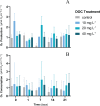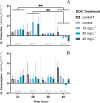Individual and combined effect of organic eutrophication (DOC) and ocean warming on the ecophysiology of the Octocoral Pinnigorgia flava
- PMID: 36814959
- PMCID: PMC9940650
- DOI: 10.7717/peerj.14812
Individual and combined effect of organic eutrophication (DOC) and ocean warming on the ecophysiology of the Octocoral Pinnigorgia flava
Abstract
Dissolved organic carbon (DOC) enrichment and ocean warming both negatively affect hard corals, but studies on their combined effects on other reef organisms are scarce. Octocorals are likely to become key players in future reef communities, but they are still highly under-investigated with regard to their responses to global and local environmental changes. Thus, we evaluated the individual and combined effects of DOC enrichment (10, 20 and 40 mg L-1 DOC, added as glucose) and warming (stepwise from 26 to 32 °C) on the widespread Indo-Pacific gorgonian Pinnigorgia flava in a 45-day laboratory experiment. Oxygen fluxes (net photosynthesis and respiration), as well as Symbiodiniaceae cell density and coral growth were assessed. Our results highlight a differential ecophysiological response to DOC enrichment and warming as well as their combination. Individual DOC addition did not significantly affect oxygen fluxes nor Symbiodiniaceae cell density and growth, while warming significantly decreased photosynthesis rates and Symbiodiniaceae cell density. When DOC enrichment and warming were combined, no effect on P. flava oxygen fluxes was observed while growth responded to certain DOC conditions depending on the temperature. Our findings indicate that P. flava is insensitive to the individual effect of DOC enrichment, but not to warming and the two stressors combined. This suggests that, if temperature remains below certain thresholds, this gorgonian species may gain a competitive advantage over coral species that are reportedly more affected by DOC eutrophication. However, under the expected increasing temperature scenarios, it is also likely that this octocoral species will be negatively affected, with potential consequences on community structure. This study contributes to our understanding of the conditions that drive phase shift dynamics in coastal coral reef ecosystemds.
Keywords: Coral reefs; Global warming; Octocorals; Organic Carbon Enrichment; Photosynthesis; Respiration.
© 2023 Zelli et al.
Conflict of interest statement
The authors declare that they have no competing interests.
Figures




Similar articles
-
Contrasting Microbiome Dynamics of Putative Denitrifying Bacteria in Two Octocoral Species Exposed to Dissolved Organic Carbon (DOC) and Warming.Appl Environ Microbiol. 2022 Jan 25;88(2):e0188621. doi: 10.1128/AEM.01886-21. Epub 2021 Nov 17. Appl Environ Microbiol. 2022. PMID: 34788073 Free PMC article.
-
Photosynthesis and respiration of the soft coral Xenia umbellata respond to warming but not to organic carbon eutrophication.PeerJ. 2021 Jul 27;9:e11663. doi: 10.7717/peerj.11663. eCollection 2021. PeerJ. 2021. PMID: 34395065 Free PMC article.
-
Excess labile carbon promotes diazotroph abundance in heat-stressed octocorals.R Soc Open Sci. 2023 Mar 15;10(3):221268. doi: 10.1098/rsos.221268. eCollection 2023 Mar. R Soc Open Sci. 2023. PMID: 36938541 Free PMC article.
-
Coral reefs under rapid climate change and ocean acidification.Science. 2007 Dec 14;318(5857):1737-42. doi: 10.1126/science.1152509. Science. 2007. PMID: 18079392 Review.
-
Effects of Ocean Warming on the Underexplored Members of the Coral Microbiome.Integr Comp Biol. 2022 Dec 30;62(6):1700-1709. doi: 10.1093/icb/icac005. Integr Comp Biol. 2022. PMID: 35259253 Free PMC article. Review.
Cited by
-
Ocean acidification and nitrate enrichment can mitigate negative effects of soft coral (Xenia) competition on hard coral (Stylophora pistillata) endosymbionts.Sci Rep. 2025 Aug 15;15(1):29937. doi: 10.1038/s41598-025-15683-5. Sci Rep. 2025. PMID: 40817345 Free PMC article.
References
-
- Adam TC, Burkepile DE, Holbrook SJ, Carpenter RC, Claudet J, Loiseau C, Thiault L, Brooks AJ, Washburn L, Schmitt RJ. Landscape-scale patterns of nutrient enrichment in a coral reef ecosystem: implications for coral to algae phase shifts. Ecological Applications. 2021;31(1):e2227. doi: 10.1002/eap.2227. - DOI - PubMed
-
- Bates D, Mächler M, Bolker BM, Walker SC. Fitting linear mixed-effects models using lme4. Journal of Statistical Software. 2015;67(1):1–48. doi: 10.18637/jss.v067.i01. - DOI
Publication types
MeSH terms
Substances
LinkOut - more resources
Full Text Sources
Research Materials

